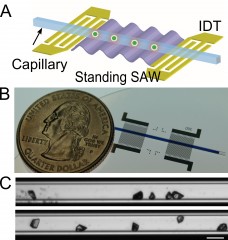Feb 6 2015
A device for precisely positioning small objects using acoustic waves has now been used to position fragile protein crystals a few micrometers or less in size in the path of a crystallography X-ray beam. This technique will make it possible to collect data on previously intractable samples and will expand the scope of what is now possible with X-ray crystallography.
 (A) Schematic of an acoustic tweezers device used to manipulate protein crystals (B) A photograph of the device compared to a US quarter (C) Clusters of crystals (top) can be separated and patterned (bottom). The inter-crystal distance is equal to one half-wavelength of the input acoustic waves. Scale bar = 100 µm. Credit:Credit: Feng Guo, Penn State
(A) Schematic of an acoustic tweezers device used to manipulate protein crystals (B) A photograph of the device compared to a US quarter (C) Clusters of crystals (top) can be separated and patterned (bottom). The inter-crystal distance is equal to one half-wavelength of the input acoustic waves. Scale bar = 100 µm. Credit:Credit: Feng Guo, Penn State
“X-ray crystallography has the capability to characterize the atomic-level details of molecules and complex structures. It enables discoveries in virtually all fields of chemistry, biology, and medicine,” said Tony Jun Huang, professor of engineering science and mechanics at Penn State. “But the biggest issue today with the technique is finding a way to handle these small and delicate crystals.”
Recent advances in modern X-ray sources and detector technology have made it possible to collect usable data on these tiny crystals. But the manipulation and mounting of crystals in the beam has traditionally been done by hand under a microscope with small needle-like cryoloops. This process is not only slow and inefficient, but is extremely difficult or impossible for very small crystals.
“The lack of robust, automated sample handling techniques prevents crystallographers from fully realizing the power of these technological advances. Our new device, which enables the precise manipulation and patterning of protein crystals using surface acoustic waves, is a transformative technology for structural biologists,” said Jarrod French, an assistant professor of biochemistry and cell biology at Stony Brook University. “This acoustic tweezers technology is a significant boon to the field of X-ray crystallography. It overcomes a significant barrier in the field by enabling the manipulation and patterning of micro- or nanometer sized protein crystals using low power, biocompatible acoustic waves.”
French and Huang’s collaboration began while French was a postdoctoral scholar in the lab of Stephen Benkovic, Evan Pugh Professor of Chemistry at Penn State. The pair are corresponding authors on a paper appearing online on Feb 2 in the journal Small titled “Precise Manipulation and Patterning of Protein Crystals for Macromolecular Crystallography Using Surface Acoustic Waves.” The lead author is Feng Guo, a Ph.D. student in Huang’s group.
Neela Yennawar, director of the Huck Institute’s Macromolecular X-ray Facility at Penn State and a co-author on the paper in Small, said “Crystallographers are pushing the boundary of biological samples being studied and moving towards more difficult targets of higher molecular weight and complexity. Acoustic tweezers will be extremely important to handle nano sized and fragile crystals of such targets. It will maximize the quality and quantity of X-ray diffraction data collected using the recently established femtosecond serial crystallography approach. This exciting field often requires vast quantities of crystals owing to the low efficiency (hit-rate) of the crystal delivery system to the X-ray beam. Acoustic methods developed in our paper promise to significantly increase the efficiency and throughput of both serial crystallography methods as well as the more conventional screening and data collection approaches.”
Acoustic tweezers is a microfluidic device that utilizes ultrasound waves produced by piezoelectric transducers to gently and precisely position biological samples without damage. The device has been used to separate different blood components, to separate cancer cells from blood and to manipulate nanorod motors inside living cells, to name only a few research areas.
Other authors on this paper are Weijie Zhou, a Ph.D. student in chemistry at Stony Brook, Peng Li, a postdoctoral fellow and Zhangming Mao, a Ph.D. student, both in engineering science and mechanics at Penn State.